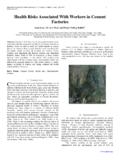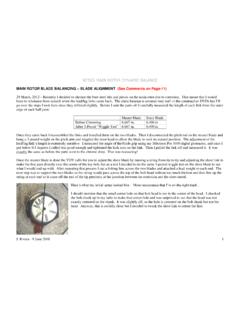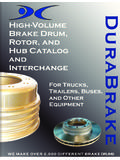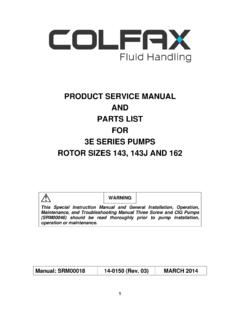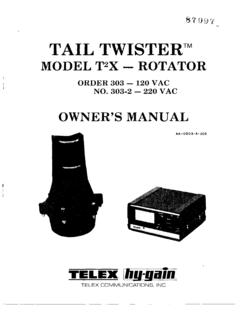Transcription of Residual Life Assessment of 60 MW Steam Turbine …
1 International Journal of Scientific and Research Publications, Volume 2, Issue 8, August 2012 1. ISSN 2250-3153. Residual life Assessment of 60 MW Steam Turbine Rotor K. Venkatesh*, P. Veera Raju**, T. Jayananda Kumar**. *. M. Tech, Department of Mechanical Engineering, Godavari Institute of Engineering & Technology, Rajahmundry, ( ), India. **. Associate professors, Department of Mechanical Engineering, Godavari Institute of Engineering & Technology, Rajahmundry, ( ), India. Abstract- Design of a component usually involves optimizing its after long year Turbine operation. These mechanism produce a dimensions to meet the operational requirements without failure progressive damage on materials that Turbine is manufactured during the design life .
2 If the operational loads are constant and with, reducing its mechanical properties. It also produces the operating temperature is not high, a component can be deviation and distortion on inner Turbine parts, becoming to designed for infinite life . However, if the operational loads are efficiency deterioration. There are two of these mechanisms that fluctuating, they cause fatigue in the component. In addition, if demonstrates to be more significant to assess the life the component operates at high temperatures for very long consumption of affected component, not only for its relation with periods, it may experience creep damage. time factor, but for the responsibility of Turbine components that With the increase of Steam turbines Steam parameter and the they, such as rotors and casings, that are large and expensive and participation in peak-load adjustment of power grid more and may produce disastrous damage.
3 The essential objective is to more frequently, the stress of the Turbine 's rotor is becoming show, according with damages produced by these two increasingly complex, and the variable thermal stress has mechanisms, the aspects involving when assessing and analyze became the major factor reducing its life . We used a 60MW Turbine remnant life in order to get life extension and recovery or supercritical Steam Turbine rotor and analyzed the variation of improvement of efficiency. thermal stress in the warm starting-up and cold shutdown Thermal power plant components are subject to both low cycle process. In this project the analysis based on the operating data fatigue damage based on number of start-ups and shut-downs as measured from actual operation and calculated the variations of well as long changes and creep damage based on number of the temperature field and stress field during the process of warm hours of continuous operation at high pressure and temperature.
4 Starting-up and cold shutdown over a period of 400 minutes with Designing every component for infinite life necessitates reducing the method of thermal-structure direct interaction analysis by the stress level below endurance limit and makes the component ANSYS. heavier and costlier. Hence, components of power plants are usually designed for finite life of about 25 to 30 years, based on Index Terms- ANSYS, Creep, Fatigue, life Assessment , Pressure assumed load fluctuation and operating parameters. Loadings, Thermal Stresses. The fatigue damage and creep damage vary for each power station and for each unit, depending on the number of shut- I. INTRODUCTION downs for preventive or breakdown maintenance and also depending on the power demand in the grid, and may not be A n important characteristic of a Steam power plant is its ability to maintain reliability and safety of the plant against frequent start-ups and load changes.
5 The rapid increase of equal to the design parameters. Considerable reserve strength and longevity could still be expected at the end of design life , temperature and rotational speed during starts-ups, especially, because of change in material data and variation of operating makes conditions more severe and causes main components' conditions from the design conditions, etc. damage and reduction of life span for Steam Turbine . Thus accurate knowledge of thermal stresses is required for the III. OBJECTIVE. integrity and lifetime Assessment for the Turbine rotor. In this Residual life Assessment (RLA) of components will help in using project, the Residual life Assessment for Steam Turbine rotor was excess life that can be derived, if necessary, by operating at part- established by combining effects of thermal stresses due to load or below- design condition on a machine- specific basis and temperature variation and stresses due to pressure load.
6 This is cost effective. Real life case studies in a number of countries study particularly focused on the time-dependent inelastic have shown that it is possible to retain the power units in service behavior (creep) of materials and cyclic loading (fatigue) under for 50 to 60 years, by periodic inspection and corrective non-isothermal conditions. Using this study, Residual life measures. Estimation of Residual life and current thermo-fatigue Assessment of Steam Turbine rotor can be obtained. We will damage of Steam turbines Rotor material. validate the results obtained from simulation with experimental Quality control of transients. values. Management of start-stop modes.
7 Solution of research tasks. II. PROBLEM DEFINITION Residual life is estimated by real-modes of loading. It is possible Damage produced by mechanisms of deterioration affecting to use individual characteristics of low-cyclic fatigue and strain Turbine integrity is directly related with times, and are produced cycling of certain rotor material. Software can be adapted for International Journal of Scientific and Research Publications, Volume 2, Issue 8, August 2012 2. ISSN 2250-3153. certain type of a Turbine . Counters allow determining rotor command revolve shown in fig-2. We have modeled the rotor individual remaining life by thermo-fatigue resistance criterion.
8 Turbine from the industrial drawing of Turbo Machinery Software and procedure development. Industries PvtLtd-Hyderabad, which is shown in fig- 3. The Software adaptation for certain equipment. Turbine rotor is axisymmetric so we considered a 2D model. Development and implementation of a project of Steam -turbines high temperature rotors Residual life . Calculations of equipment Residual life . Steam Turbine Turbine is an engine that converts energy of fluid into mechanical energy. Steam turbines are machines that are used to generate mechanical (rotational motion) power from the pressure energy of Steam . A Steam Turbine is a device that extracts thermal energy from pressurized Steam and uses it to do mechanical work on a rotating output shaft.
9 Its modern manifestation was invented by Sir Charles Parsons in 1884. Steam turbines are the most popular power generating devices used in the power plant industry primarily because of the high availability of water, moderate boiling point, cheap nature and mild reacting properties. The most widely used and powerful turbines of today are those that run on Steam . From nuclear reactors to thermal power plants, the role of the Steam Turbine is both pivotal and Figure-1 2D sketch of a Rotor. result determining. Because the Turbine generates rotary motion, it is particularly suited to be used to drive an electrical generator about 90% of all electricity generation in the United States is by use of Steam turbines.
10 The Steam Turbine is a form of heat engine that derives much of its improvement in thermodynamic efficiency through the use of multiple stages in the expansion of the Steam , which results in a closer approach to the ideal reversible process. IV. MATERIALS. It is generally known that rotors made of high CrMoV steels (customary: 9% up to 12%Cr) show bad running behavior in babbitted bearings. Therefore it is necessary to coat the journal areas of such rotors with materials which prevent the known wire Fig-2 3D model of Rotor. whooping effect and improve the performance. For safety reasons, those materials are normally applied by overlay welding. A low alloy MnCr weld metal with an approximately 0,2 %.









